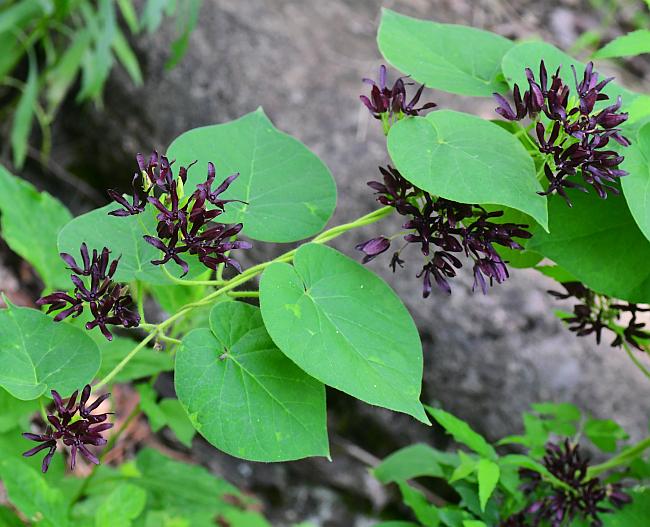Matelea decipiens (Alexander) Woodson
Climbing Milkweed

Native
CC = 5
CW = 5
MOC = 46
© SRTurner
Matelea decipiens (Alexander) WoodsonClimbing Milkweed | |
 |
Native CC = 5 CW = 5 MOC = 46 |
© SRTurner |
|
Family - Asclepiadaceae Habit - Perennial vining forb. Stems - Trailing and climbing on other vegetation, to 3 m, herbaceous, with milky sap, scabrous, pubescent, branching, multiple from a thickened crown.
Leaves - Opposite, simple, petiolate. Petioles to 5 cm long, scabrous from papillose-hispid hairs, also with minute hispidulous hairs, with numerous reddish glands (visible with magnification). Blades broadly ovate, 4-15 cm long, the tips sharply pointed, deeply cordate at the base, entire, the surfaces pubescent with short hairs and minute glandular hairs.
Inflorescence - Solitary umbellate clusters in the leaf axils. Peduncles to 3 cm long, hispidulous and glandular. Pedicels to 1.4 cm long, hispidulous and glandular, typically with a purplish tinge. Flowers typically 4-25 per umbel.
Flowers - Calyces greenish, the 5 lobes 2-4 mm long, lanceolate to ovate, moderately to densely pubescent on the outer surface with short hairs and also minute glandular hairs. Corollas with the 5 lobes 7-18 mm long, narrowly oblong to narrowly oblanceolate or linear, dark purple to nearly black, moderately pubescent on the outer surface with short hairs and usually also sparse, minute glandular hairs (these difficult to see against the dark background color). Corona 3 mm in diameter, glabrous, dark purple to nearly black, the 5 lobes rounded to broadly and bluntly triangular, the appendages about twice as long as the lobes, each deeply divided into 2 narrowly triangular, sharply pointed lobes. Anther head 2 mm in diameter. Pistils 2, tuberculate, light green, 2 mm long in flower.
Fruit - Follicles 8-11 cm long, pubescent, covered with slender warty projections. Seeds 8-9 mm long, ovate, narrowly to relatively broadly winged, the terminal tuft of hairs to 3 cm long, white to light cream-colored or tan.
Flowering - May - June. Habitat - Glades, savannas, bluffs, forests, streambanks. Origin - Native to the U.S. Lookalikes - None when flowering. Other info. - This striking and unmistakable plant is common throughout most of the southern half of Missouri, uncommon to absent in the northern half of the state. The southern half of the state forms the northern part of the plant's natural range, which is mainly contained within a well-defined cluster extending southward not quite as far as the Gulf Coast. The plant is easily recognized by its hairy vines, heart-shaped opposite leaves, and clusters of brown flowers. The flowering time is short but the plant still deserves more attention in cultivation. Photographs taken in Greensfelder County Park, St. Louis County, MO, 6-1-2011; Washington State Park, Washington County, MO, 6-23-2011; Matson Hill County Park, St. Charles County, MO, 5-17-2012; Shaw Nature Reserve, Franklin County, MO, 5-30-2014 and 5-20-2022; Little Lost Creek Conservation Area, Warren County, MO, 6-3-2018, and Matson Hill County Park, St. Charles County, MO, 6-8-2020 (SRTurner); also at Valley View Glade Natural Area, Jefferson County, MO, 8-2-2021 (KBildner). |